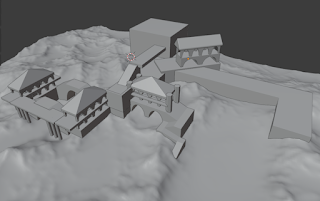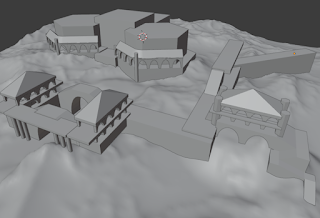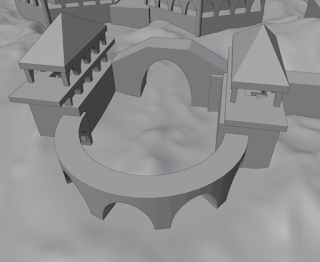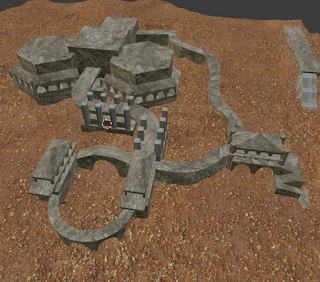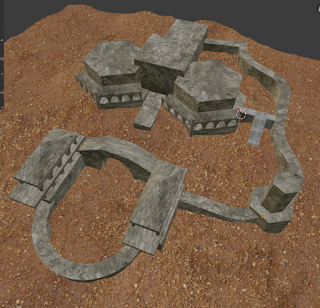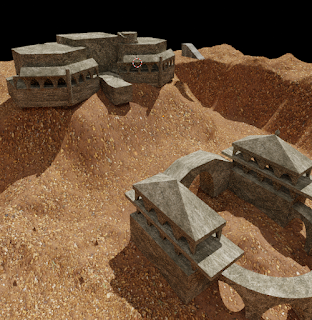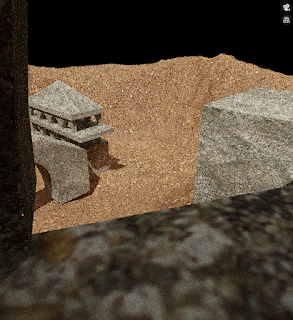creator-wizard-seth.blogspot.com is my blog for you to read more content. www.creatorwizardseth.com
The Interplay of Structures and Terrain
With my accepting of using terrain in the earlier version of my map creation I am seeing the challenges and the flexibility in the terrain. The flexibility is literal, as it is a flat plane with a texture and using certain editing tools I can pull it and move it around and stretch it as if it was a piece of cloth or clay. I can make it fit around buildings as if someone had taken a shovel and excavated a foundation for the building and then filled in dirt around in to make it look nice. There is a lot more visual flexibility and potential for beauty in placing trees as a gardener would or an architect choosing a place for a tree to be placed. Terrain certainly is a challenge to get used to but the benefits and potential are well worth the invested energy. My alternative is to invest energy into easier and simpler but worse and less beautiful methods and then my time will have been used less effectively and trying to market the game becomes harder and harder. So now, it is to learn structures, and to learn terrain, and then learn to combine them in interesting and appealing new ways.
Vantage Points, Surveying your Scene. Measuring Time and Space
One thing that you don't want is areas of your map that are empty. Computer games are inherently boring and giving the player a few moments to doze off and fall asleep will guarantee the failure of your project. I spend a lot of time in a scene placing the camera in the point of view of a player and moving around and measuring the time it takes to get from one place to another and measuring the amount of choices the player has and use this information to try and come up with an action to continue the development of my environment. Balance is the key to everything and your features and their spacing being too large or small will make or break the design of your environment.
The expansion that can occur in the human mind
We as humans are creative and expansive. We can take a look at a few pillars, an archway, and a staircase and we can assemble them in our minds into coherent structures. We can also take these elements and expand them from nothing and create different elements to work with. Truely we as humans have magical creative capabilities that must come from a higher dimension.
Sometimes getting the right result is a matter of convergence. Sometimes you do not even know your exact desired result and are creating in a fully dynamic and unrestrained way and all you know is. This looks too big, this looks too small, this is too crowded, or sometimes just.... something doesn't feel right. All we must do is continue to try the result in a similar technique and make our necessary adjustments until we converge on something that seems right. It's even harder to do before we have developed a real sense of intuition and vision and proportions. The amount of experimenting needed to get a result that is satisfactory, not necessarily the exact recipe you were following will decrease as your own abilities and wisdom grow. It's important that you continue to see building as a constant expansion and learning process as you can never fully master it unless you truly find the source of the universe in geometry itself.
Cosmetic improvements basically means adding detail. Detail is anything that does not change the shape of the object in a way that impacts gameplay. You can have scenes with lots of detail that still have low geometric complexity and when we remove all the fine details we can see where the scene is really lacking in its structural integrity. This can be a complex pillar instead of a cylinder, or a trim along a wall corner, torches on a wall, or anything beyond primitive geometry.
Choices
It's important to realize that when we are creating a game environment to play in, it is for the purpose of play. We are not designing a manufacturing facility for a company to manufacture cars or airplanes. We are not doing architectural design for a bakery or building an office complex for a law firm. We are intending our environment to be played in. The main difference between a game and a task is that a game specifically must offer you choices. In laying out the objects in your scene in a certain way you are presenting choices to your player for what direction they wish to take.
The game and the map is one entity. There is no seam between game design and map design. The map is the game. The game is reflected in the nature of the map. Fortress assault is the game, so fortresses are the map theme. Towers, Bunkers, Stairways, Wall Systems, Courtyard variations define the nature of the structures in this specific variation. There are an infinite number of ways to design a tower, a bunker, a stairway system, ladders, elevators, buttons, gates, switches.
Constraints are very useful in designing environments. Unless you have lots of creative resources you will be forced to work with constraints to limit the scope of your creation to make its creation feasible with what you have to work with. Sometimes you are forced to design the game in a minimal way to avoid spreading your energy too thin.
Energy Management for Game Design
The creation of your video game actually has less to do with the amount of hours you spend developing and more about the development that you take within yourself. Many game developers make the mistake of sacrificing their mental and physical health to try and force their game to be completed earlier. This accomplishes only the opposite. Having not the energy to create efficiently you will end up moving exponentially slower than you would have had you conserved and managed your emotional and mental resources more wisely. When it comes to hours spent working on the computer, less is more. And when you start to feel exhausted and tired, get off the computer. Be patient, it will become completed. Unless of course you try to force it to be done sooner than you will only be done later and your quality of life will be lower and the result of your work will be less.
Let's begin todays visual portion by looking at some more progress with my city fortress design.
Here I take a step forward by making the main central structure symmetrical.
Changing the front of the entrance to a semi circle archway. Looks much better and more dynamic and interesting than the previous approach.
Making the wall system going around the perimeter curved, not straight. Makes walking on it much more interesting.
Here I have replaced a more disgusting feature with a hexagonal tower base.
And here I have introduced a hill and placed the structure on top the hill. This is a big deal and actually will require me to completely trash this scene and start back again from scratch. This time I will design the terrain around the structures, and the structures around the terrain.
To end things, here is a first person view from on the hexagonal patio. The next version of my environmental design will start with developing the terrain more completely so I can more easily visualize where the structures should go and what shape they should be. Of course this is also a matter of convergence, altering the terrain to fit the structures, and the structures to fit the terrain until we find the perfect balance.
